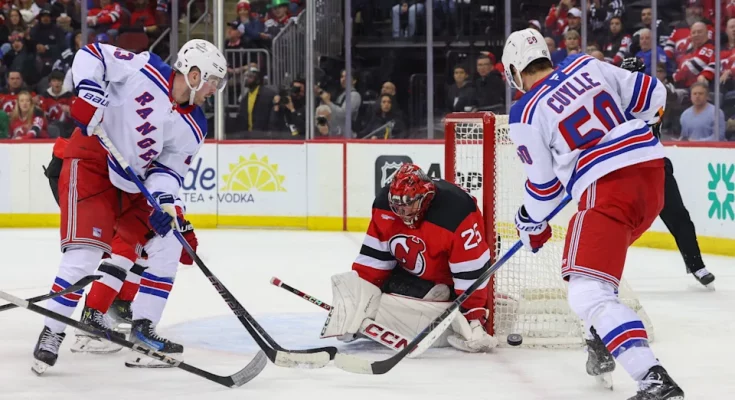The tri-state rivalry between the New York Rangers, New York Islanders, and New Jersey Devils is one of the most heated and historic in all of hockey. These three teams don’t just share geographic proximity—they share a deeply rooted competitive fire that’s shaped by decades of playoff battles, organizational triumphs, collapses, rebuilds, and generational stars. As the 2025-26 NHL season approaches, the stakes are as high as ever in the battle for New York supremacy. Each team finds itself at a different point in its developmental arc, yet all are aiming for playoff contention, legacy-defining seasons, and, ultimately, a shot at the Stanley Cup. So how do the Rangers truly compare to their local rivals, the Islanders and Devils?
For starters, the Rangers are perhaps the most headline-grabbing of the trio, with the Madison Square Garden spotlight never dim. They boast a team constructed around star power, balance, and high expectations. Artemi Panarin remains one of the league’s elite offensive weapons, even as questions swirl about his long-term future with the franchise. Adam Fox is a Norris Trophy-caliber defenseman whose intelligence, skating, and puck distribution separate him from nearly every other blue-liner in the league. Igor Shesterkin continues to be a world-class goaltender and the backbone of the team, capable of stealing games when the offense sputters. Complemented by a developing core that includes Alexis Lafrenière, Kaapo Kakko, and Braden Schneider, the Rangers offer both experience and potential. After a disappointing playoff exit last year, the organization opted to retain much of the current core, betting on chemistry and incremental improvement rather than dramatic overhaul.
The Islanders, on the other hand, operate in a drastically different team-building philosophy. They are structurally defensive-minded, emphasizing physicality, responsible play, and goaltending above flash and flair. While the Rangers dazzle, the Islanders grind. Mathew Barzal is still the team’s most skilled forward, but his offensive production has been inconsistent due to injuries and a lack of top-line support. Bo Horvat was brought in to change that, offering leadership and two-way acumen. Behind them is a veteran-laden group with depth and durability, if not elite scoring. The Islanders’ true strength lies between the pipes with Ilya Sorokin, who has proven to be every bit as good as Shesterkin and in some stretches, arguably better. With Sorokin, they always have a chance, and under a disciplined system, they can frustrate more talented teams. Still, their ceiling often feels capped. They struggle to keep up with more dynamic opponents and have yet to prove they can string together a deep playoff run in recent years.
Meanwhile, the New Jersey Devils present the most intriguing case of all three. After years of rebuilding, the Devils have burst into contention with a fast, young, and fearless roster. Jack Hughes has blossomed into a bonafide superstar, dazzling with speed, creativity, and a scoring touch that ranks him among the NHL’s most electric players. Nico Hischier, Jesper Bratt, Dawson Mercer, and Timo Meier add layers of depth and versatility to the forward group. The blueline is anchored by Dougie Hamilton and bolstered by the arrival of young studs like Luke Hughes and Simon Nemec. If the Rangers are balanced and the Islanders are defensive, the Devils are pure speed and offense. They thrive in transition, attack off the rush, and overwhelm slower teams with pace. However, their glaring weakness remains in net. Despite experimenting with multiple goaltenders, consistency has eluded them. Until that changes, the Devils may find themselves struggling to keep up in high-pressure, playoff-style games where goaltending makes or breaks championship runs.
When measuring where these teams stand relative to each other, the Rangers arguably offer the most complete roster. Their mix of seasoned stars, youth movement, goaltending stability, and playoff experience positions them well for short-term success. However, they also carry the weight of expectations. Anything less than a deep playoff run is viewed as failure. The Islanders, though less flashy, bring a steadiness and physicality that can prove valuable in a playoff series. Their biggest concern is scoring—without offensive firepower, they may simply not have the tools to keep pace with teams like the Devils or Rangers. The Devils possess the highest offensive ceiling, but their goaltending and defensive structure have yet to match their firepower, which could keep them from making that final leap.
One of the most fascinating aspects of this rivalry lies in the differences in organizational identity. The Rangers have always been seen as the big-market team with the deepest pockets and brightest spotlight. They attract stars and headline signings, and their fanbase spans globally due to their iconic branding and historical prominence. The Islanders, with their more blue-collar roots, cultivate an identity that embraces toughness and defensive grit, much like their glory days of the 1980s. The Devils, historically seen as the suburban afterthought, flipped that script in the 1990s and 2000s with a dynasty fueled by defense and Martin Brodeur. Now, they’re rebranding themselves once again as the new-school, offense-first juggernaut with youth and swagger.
In head-to-head matchups, the Devils have had the Rangers’ number recently, particularly with their blazing speed and relentless offensive pressure. In the 2023 playoffs, they shocked the Rangers by storming back from a 2-0 deficit and winning the series in seven games. That defeat still stings for Rangers fans and added urgency to the franchise’s decisions over the last two seasons. The Islanders, meanwhile, have often played the role of spoiler. Despite lacking the firepower of their neighbors, they’ve consistently managed to play tight, low-scoring games and frustrate more skilled opponents. Their rivalry with the Rangers is less about playoff drama and more about regional pride—every matchup feels personal, every check is heavier, and every goal reverberates a little louder.
All three fanbases are deeply passionate and extremely territorial. Rangers fans pride themselves on being the face of New York hockey, steeped in the glamour and legacy of the franchise. Islanders fans, proud of their Long Island roots, rally behind their gritty underdog mentality. Devils fans, often feeling overlooked, carry a chip on their shoulder and point to their three Stanley Cups as proof of their relevance. Each rivalry game becomes a referendum not just on wins and losses, but on identity and respect.
Looking ahead, the race for New York dominance may come down to which team can fix its biggest flaw first. For the Rangers, that means finding the consistency in their young forwards and ensuring Panarin and Fox stay elite in high-leverage moments. For the Islanders, it’s about injecting enough scoring to make their style sustainable in the modern NHL. For the Devils, it’s about shoring up the crease and learning how to play defensively responsible hockey without compromising their offensive strengths.
Front office decisions will be crucial. The Rangers have shown faith in their current leadership but face big questions surrounding long-term contracts and cap management. The Devils are still reaping the rewards of successful drafting and savvy trades but may soon need to make tough calls on which young stars to keep. The Islanders remain more cautious in their approach, placing value on loyalty and structure, though that strategy may need to evolve if they want to keep pace with their flashier rivals.
In terms of future trajectory, the Devils may have the brightest long-term outlook given the age of their core and the upside of their talent. However, in the immediate term, the Rangers arguably offer the best combination of elite goaltending, defensive stability, and high-end forwards to win now. The Islanders remain competitive, but without a more dynamic offensive presence, they risk falling into irrelevance in the face of younger, faster opponents.
Ultimately, the battle for New York supremacy is not just about standings. It’s a cultural war, a showcase of hockey philosophy, and a microcosm of the NHL’s broader evolution. Each team brings something different to the table, and that diversity only strengthens the rivalry. Whether it’s a primetime showdown at Madison Square Garden, a raucous night at UBS Arena, or a fast-paced tilt at the Prudential Center, every game between these three is must-watch hockey. And as the 2025-26 season unfolds, expect the rivalry to intensify, the stakes to rise, and the question to remain as relevant as ever: who truly owns New York hockey?



